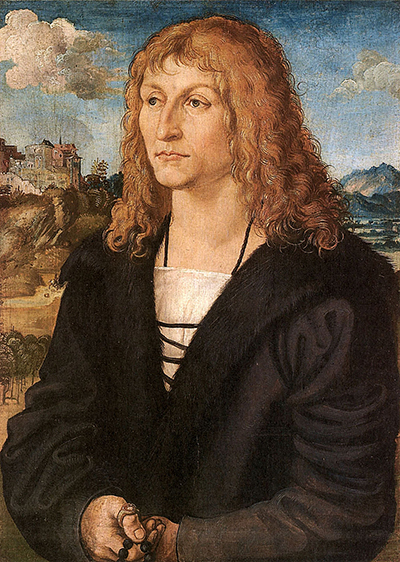This memorable portrait of circa 1500 was completed by Lucas Cranach the Elder, one of the stars of the Northern Renaissance.
This carefully crafted artwork features a portrait in the foreground plus a supporting landscape that sweeps across the background. It leaves us with a painting that has much detail to enjoy, though this particular artwork is not actually one of the artist's most well known. Cranach was a well connected artist who received a number of high profile commissions during his time as a court painter, so it is quite likely that the gentleman found here was of high standing in the artist's local region. Sadly, he has never been confidently identified, though several different theories have been put forward over the centuries that have passed since. Personally, one can not get away from the resemblance to this Albrecht Durer portrait painting, though it could well be purely a concidence.
The middle aged man sports long, curly hair and looks off to the left of the scene. He wears a ring on his right hand and also holds some beaded jewellery. His clothing is very simple, with a white shirt below a dark coat. He looks pensive, perhaps enjoying the countryside around him. A few clouds dot the blue sky whilst a cliff top village can be seen to the left hand side. Several hills lead up to these buildings and there is also a hilly region on the other side of the painting too. During this period there were no landscape painters, as such, with landscape scenes being used to support other foreground elements. It was only later that artists such as William Turner would produce paintings that included only the features of a landscape scene, with no human involvement at all.
Cranach produced several hundred artworks during his long and extensive career and this particular piece is not considered one of the most famous from his series of paintings. That said, there is plenty of quality to be enjoyed here and perhaps if the gentleman had been identified then we may have seen more focus on the history of this artwork. Cranach himself also achieved success in a number of other mediums too, such as woodcuts too, in conjunction with Albrecht Durer who was the figurehead for German art at this time. Focus on Italian art during these years has led to some of these artists originally being ignored outside of the boundaries of their own nation, but this has clearly changed considerably over the past two centuries.




